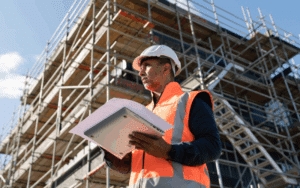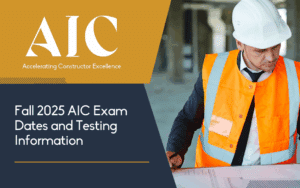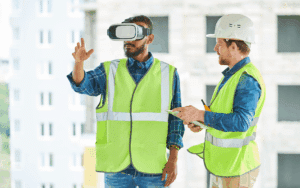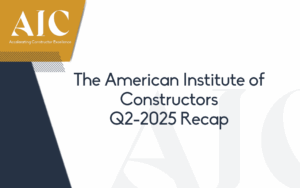Virtual reality in construction has the power to transform construction projects, helping cut costs and reduce errors along the way. In practice, virtual reality (VR) technology is one of the latest construction technology tools that is replacing guesswork and costly surprises with precision, insight, and collaboration.
Imagine stepping into a building before a single wall is raised, spotting opportunities and correcting mistakes in a fully interactive 3D model. No longer confined to “that would be nice to have” brainstorms, VR technology is available and ready to support your project needs.
In fact, VR is now an essential tool in construction design work to help bring ideas to life, streamline workflows, and support real-time decisions. Let’s look at how this powerful tool is transforming every stage of the construction process – from design and safety training to on-site coordination and beyond.
What is Virtual Reality in Construction?
Virtual reality in the construction industry involves utilizing VR technology to create computer simulations of real-world construction projects. By donning a VR headset, construction workers and project stakeholders can enter a virtual environment that showcases 3D models of buildings, infrastructure, and construction sites before any physical work commences.
Unlike traditional training or design methods, VR enables real-time interaction, allowing teams to walk through proposed layouts or simulate specific scenarios.
These capabilities are designed to help construction companies identify potential issues early in the project lifecycle and make data-driven decisions that improve project outcomes before a shovel ever hits the ground.
How Virtual Reality is Transforming Construction
The capabilities of VR technology extend across numerous aspects of building and construction. Consider some of the most impactful ways virtual reality technology is reshaping the reality of construction projects.
1. Enhanced Design Visualization with 3D Models
One of the most significant advantages of VR in construction is its ability to bring 3D models to life. Traditionally, blueprints and static renderings were the go-to tools for visualizing construction designs. Now, VR technology can take things a step further with fully interactive, immersive experiences. Stakeholders can now perform these tasks:
- Enter virtual environments to explore full-scale simulations of construction projects.
- Test design elements in real-time, making adjustments to layouts and features.
- Detect design flaws before physical construction begins, reducing costly rework.
For example, a team designing a corporate office may use VR simulations to identify potential issues with workspace ergonomics. By addressing these problems in the virtual stage, construction companies can save substantial costs and avoid mid-project changes.
2. Improved Communication Across Construction Sites
Miscommunication during construction projects often results in delays, errors, or cost overruns. VR addresses this challenge by serving as a bridge between different stakeholders.
AEC industry partners, such as architects, engineers, and construction managers, can collaborate within the virtual environment, ensuring a shared understanding and alignment. The key benefits of this approach include:
- Real-time virtual meetings inside a simulated construction site.
- Ability to overlay building information modeling (BIM) data onto VR simulations for streamlined planning.
- Assurance that every team member shares a unified vision of the project.
Such collaboration has proven especially effective in minimizing errors during large, multidimensional projects like hospitals, apartment complexes, and industrial facilities.
3. Revolutionizing Safety Training
Construction is one of the most hazardous industries in the U.S., and safety training is critical for reducing workplace accidents. Virtual reality is revolutionizing safety programs by creating simulated real-life scenarios where workers can learn and practice without taking on actual risks. Here’s how it works in real-world environments:
- Team members can practice high-risk tasks – such as operating heavy machinery or working at heights – in a virtual environment that mirrors a real-world setting.
- Construction workers are better prepared with safety support mechanisms like simulated accident response drills.
- Unlike traditional training methods, VR programs allow trainees to repeat tasks until they achieve full confidence, improving long-term safety outcomes.
By utilizing VR-based training programs, construction companies can better equip their teams with the skills they need while protecting them from unnecessary exposure to risk.
4. Faster Project Planning and Execution
VR technology can help streamline the logistics of construction sites. VR simulations provide construction managers with tools to optimize project workflows, saving valuable time and resources. Some key features of VR in project planning include:
- Testing the sequence of construction phases to identify potential bottlenecks.
- Visualizing equipment placement and personnel movement for maximum efficiency.
- Gaining insights into cost and time savings by simulating different scenarios.
For example, teams managing a complex renovation project might utilize VR technology to plan nighttime work schedules and avoid disruptions to daily operations. The foresight gained from VR can enhance execution and help keep the project on schedule.
5. Proactive Identification of Potential Issues
Errors during construction projects are costly, not just financially but also in terms of time and company reputation. Virtual reality technology enables construction companies to detect and address critical issues during the pre-construction phase.
Using VR to test construction concepts may create the following benefits:
- Resolve structural conflicts, such as misaligned pipes or ventilation systems, before construction begins.
- Assess how architectural elements fit together, creating a seamless final product.
- Verify that what’s visualized in the virtual environment will translate accurately to the real world.
The goal is to make it easier for construction teams to avoid disruptions and effectively manage project risks before any work begins in the field.
Core Benefits of Virtual Reality in Construction
We’ve unpacked some of the best uses of VR technology in construction project delivery. Consider the overall benefits of incorporating this tool into your project management plans.
1. Cost Savings
VR technology helps create cost savings by eliminating rework, improving material estimates, and reducing unnecessary expenses. Safety training programs further lower costs associated with accidents and insurance claims.
2. Precise Project Execution
The integrations of BIM technology and 3D models into VR simulations ensure higher precision and fewer mistakes during construction projects. Teams can execute projects exactly as designed, resulting in improved quality.
3. Fewer Delays
By enabling real-time project adjustments and providing immersive visualization, VR allows teams to collaborate more effectively and make informed decisions during the planning and construction phases.
This technology can also help with identifying potential design flaws, structural issues, or logistical challenges early on. The result is reducing the likelihood of costly delays that often surface during traditional construction processes.
4. Increased Worker Readiness
Well-trained construction workers are essential for project success. Providing workers with a view of the project before they begin work can help them better visualize how their piece of the puzzle fits together into the overall project plan.
VR-supported project training and safety information can give team members the skills and confidence they need to perform effectively on construction sites.
Learn More About Tech Trends in Construction Management
Virtual reality in construction is no longer just a nice idea. It’s one of the most powerful tech trends that can transform how construction companies manage projects from start to finish.
By improving design accuracy, streamlining collaboration, and enhancing safety support, VR technology addresses many of construction’s most pressing challenges. Whether refining a 3D model or training construction workers in a risk-free virtual environment, VR offers significant cost and time savings.
To know more about the latest trends affecting construction managers, follow the American Institute of Constructors (AIC) on LinkedIn. We regularly share news updates and industry articles to guide constructors on how to be a leader in our rapidly changing industry.
We look forward to supporting your use of virtual reality in construction to advance construction management.




